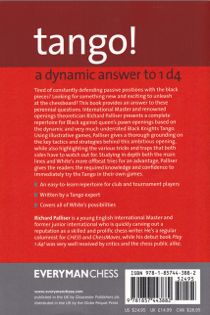Tango! A Dynamic Answer to 1.d4
Richard Palliser

Many years ago I happened upon a magazine format analysis by IM Georgi Orlov on an interesting Black opening system called The Black Knights Tango (1.d4 Nf6 2.c4 Nc6). At first I thought the Tango was garbage, but a closer look convinced me it was far more interesting than one might imagine many of the lines lead to exciting tactics where Black has all the fun, while others lead to heavy duty positional struggles that suited me to a tee.
I jumped into the opening and came up with my own assessments and ideas. At the time, I felt that:
1) Attempts at refutation (1.d4 Nf6 2.c4 Nc6 3.d5) give White nothing, and indeed put the first player at risk in many of the lines.
2) Generic responses also give White nothing, and at times even lead to complete disaster. For example, I am constantly amazed by the number of players that fall for this sequence in blitz AND in tournament games: 1.d4 Nf6 2.c4 Nc6 3.Nc3 e5 4.d5 Ne7 5.e4 Ng6 6.Bd3 Bc5 7.Nge2 and now 7 …Ng4 is crushing (8.0-0 Qh4).
3) The main line (if a main line of the Tango really exists) might be 1.d4 Nf6 2.c4 Nc6 3.Nc3 e5 4.d5 Ne7 5.e4 Ng6 6.Be3 Bb4, but this position attracted me then and still does today.
4) Transpositions to the Nimzo-Indian (1.d4 Nf6 2.c4 Nc6 3.Nf3 e6 4.Nc3 Bb4 5.Qc2) and the Bogo Indian (1.d4 Nf6 2.c4 Nc6 3.Nf3 e6 4.g3 Bb4+) are eminently playable, if not quite what I personally wanted.
5) White has two outright tries at refutation: 1.d4 Nf6 2.c4 Nc6 3.Nf3 e6 4.a3!? (which I used as White to win a quick game) and 1.d4 Nf6 2.c4 Nc6 3.Nc3 e5 4.d5 Ne7 5.e4 Ng6 6.h4!?.
Some time after Orlovs pamphlet appeared, his work got wider attention when Batsford published (in 1998 128 pages) THE BLACK KNIGHTS TANGO (also by Orlov), which was by far the best source for Tango information at that time. However, since then the popularity of the Tango has skyrocketed, and grandmasters like Bologan, Larry Christiansen, Joel Benjamin, and Alex Yermolinsky use it often. Thus, a new source of theoretical information was needed, and Richard Pallisers TANGO! fits the bill wonderfully with 192 information/analysis packed pages.
Looking through TANGO!, one message comes across loud and clear: the Tango is alive and well! Of my listed points above, I was pleased to see that the mainline (1.d4 Nf6 2.c4 Nc6 3.Nc3 e5 4.d5 Ne7 5.e4 Ng6 6.Be3 Bb4) was represented by my win against grandmaster Dao Thien Hai (Budapest 1994) AND with a game of one of my students (Tim Taylor – Vanessa West, LA 2004), who played very sharply to gain a significant advantage against an experienced IM.
Of my two Tango fears, 1.d4 Nf6 2.c4 Nc6 3.Nc3 e5 4.d5 Ne7 5.e4 Ng6 6.h4!? no longer seems to be a danger. However, 1.d4 Nf6 2.c4 Nc6 3.Nf3 e6 4.a3!? is still a serious option for White Kasparov used it to beat Yermolinksky and, subsequently, 4.a3 was recommended by Khalifman in his OPENING FOR WHITE ACCORDING TO KRAMNIK.
In TANGO!, Palliser recommends one system against 4.a3: 4… d6 5.Nc3 g6 which Bologan has shown to be satisfactory for Black. Indeed, this is pretty much how everyone plays against 4.a3 now. Nevertheless, 4 …d5 5.Nc3 is mentioned, when Palliser feels that my discovery of 5… a6!? is most likely best, but still inadequate for equality: 6.cxd5 (My idea was that 5 …a6 more or less forced this reaction, thereby cutting down on Whites options. If 6.Bg5, Black has 6 …dxc4 7.e4 b5 8.e5 h6 with advantage.) 6 …exd5 7.Bg5 Be7 8.e3 h6 9.Bh4 0-0 10.Bd3 with a small plus for White in Kasparov-Yermolinsky, Yerevan 1996.
With all pure Tango lines viable, that leaves White having to rely on transpositions to the Nimzo and Bogo in his search for a serious opening advantage. Here Palliser does a wonderful job exploring these possibilities, giving detailed coverage of the Zurich Variation (1.d4 Nf6 2.c4 Nc6 3.Nf3 e6 4.Nc3 Bb4 5.Qc2).
Against 1.d4 Nf6 2.c4 Nc6 3.Nf3 e6 4.g3, Palliser points out that, aside from 4… Bb4+ (the Bogo-Indian), Black can also try 4… d5, entering a sharp line of the Catalan. His sixteen page analysis of this anti-Catalan system leaves Tango players feeling all warm, fuzzy, and full of confidence.
TANGO! is a must buy for anyone wishing to play this system as Black, and a sound purchase for any 1.d4 player who will have to meet it as White. Unfortunately, it seems that Everyman Chess is, at the moment, only offering this title as an ebook.
